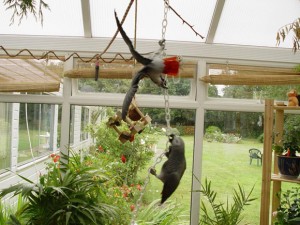Enrichment on a Budget
Dorothy has some useful ideas on how to keep your parrots happy without spending a fortune
Why bother making toys?
Why make or purchase toys for parrots? Such intelligent and active creatures are forced to make an enormous adjustment to adapt to a human-orientated life. In their natural environment, through thousands of generations, parrots have developed acute senses and elaborate social behaviour.
A wild parrot needs to remember where the food sources are and when they are ripe. It needs to evaluate safe roosting spots and find nesting sites. It needs to find a mate, and a wild parrot faces threats from nature and predators - dangers such as droughts, hurricanes, snakes, rats, hawks and other hunters. The recompense for this is the freedom of the skies and the company of its own kind.
The captive parrot faces none of these challenges or rewards, although it retains the inborn potential to do so. In captivity, its life may well be lonely and monotonous for a large part of its day. The provision of an environment that mimics some of the challenges and benefits of the wild state is something worth aiming for; a well-stocked cage, a supply of toys for active minds, and if the bird has use of an aviary, sufficient enriching items kept inside.
Making your own toys, foraging and enrichment activities makes good financial sense - and your parrots will love you for it. When you construct toys in their presence, they will try and help, by opening jars and boxes, and removing tools to safer spots on the table. Your flighted parrot will enjoy flying off with them – so beware. Expensive, bought items are not necessarily preferred to humble household ones. If you have ever had the rueful experience of buying a brand new toy for a toddler, you’ve probably experienced that moment when the child starts playing with the box and the wrapping paper with total absorption - and ignores the costly gift. With ingenuity you’ll find inexpensive household items for your pet birds everywhere you look - empty toilet rolls, wooden cooking spoons, plastic plant pots, corks, Christmas cards, junk mail. If making parrot toys becomes a bit of a hobby, you’ll develop a keen eye. Your friends will start to keep their wine corks for you. Keen walkers will bring home fir cones. The list goes to infinity.
Ropes and Swings
My favourite parrot attraction has to be ropes. Our four pet birds live in an adapted conservatory, but have regular out times where they are at liberty in certain rooms. Bedrooms and husband’s office are off limits. A familiar cry in our house is “Pout,” as Wal shouts at Perdy, the cockatoo, who has flown into his office to find him. For second best, she flies into my office and has her own ropes - a skipping rope across the ceiling with chewables hanging from it. The rope’s plastic handles are nearly chewed through, and it will soon need replacing. In their permitted rooms, the parrots’ ropes criss-cross the ceiling. In the sitting room, these ropes are looped onto hooks, so that they can be taken down for non-parrot occasions. Since ropes are not stable, but sway like branches in the wind, they provide an immense amount of acrobatic activity. Hemp clothes lines are the best value for money and they look more natural than plastic or nylon ropes.
When you allow your parrot out-of-cage-time, ropes are a marvellous way to discourage it from landing on places you’d prefer it didn’t. Stretch the rope in the right place and hang enticing items from it. I have managed this (just) in the sitting room. Casper and Perdy will stay on their ropes, but Lily, the Lesser Sulphur Crested Cockatoo - the most recent arrival who has come from a sanctuary - is not yet confident or agile on ropes. She prefers solid footing beneath her. She has been allowed to colonize her own bookshelf, furnished with a collection of unwanted paperbacks. She will spend literally hours chewing through the books. I know this is nesting behaviour which it is not ideal to encourage, but it keeps her content and helps prevent her from plucking out her feathers.
Warning
Ropes can be a danger if the ends are frayed and if they are not kept taut. Parrots have been injured and even killed by badly maintained ropes, so they must be checked regularly for wear and tear.
Another useful, inexpensive climbing toy can be made from wooden coat hangers. Hook a clothes hanger to the bottom of the first, and hook a third to the second and you have a dangling climbing frame that attaches to a rope or a ceiling hook. When Artha and Casper were younger, they loved weaving in and out of the coat hangers. We called it ‘playing circus parrot’. In their young maturity, however, (they are rising 10 and 7) they seem to have grown out of this beguiling habit.















